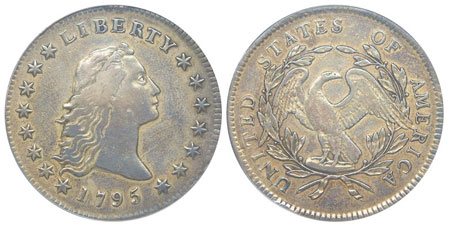Guide to U.S. Flowing Hair Dollars
The Coinage Act of 1792 officially established the United States Mint and authorized the issuance of coins across ten denominations struck in copper, silver, and gold. Among these, the silver dollar held a key position within the new monetary system as the standard unit of money. The Flowing Hair Dollars represented the first series of silver dollars, issued for only two years from 1794 to 1795. The first year of issue carries great historical importance and is recognized as a significant rarity within American numismatics.

The Flowing Hair Dollar was designed by Robert Scot, the first Chief Engraver of the United States Mint. The obverse features the head of Liberty, facing right with large locks of flowing hair. Above the image is the word “LIBERTY”. Eight stars are positioned to the left and seven stars are to the right, together representing the fifteen states in the Union at the time the pieces were struck. The date appears below.
The reverse design features a bald eagle, perched with its wings spread, fully surrounded by a wreath. The widely spaced inscription “UNITED STATES OF AMERICA” surrounds the image. As was the case for other early gold and silver coins, the face value is not indicated within the design. Instead, the denomination appears as edge lettering, reading “HUNDRED CENTS ONE DOLLAR OR UNIT”. This particular wording references the Coinage Act of 1792, within which the denomination was referred to as “dollar” or “unit”.
The first silver dollars were struck on October 15, 1794 from a single pair of dies on a screw press which was usually used to produce copper cents and silver half dollars. The small press would prove inadequate to strike the larger-sized silver dollars and cause various problems. Early within production, the dies clashed and were lapped, partially removing the clash marks. Later, the dies would be lapped again, fully removing the clash marks. Additionally, the coin dies shifted at some point in the production process, resulting in weak strikes especially notable on the left side of the obverse.
From the initial quantity of 2,000 silver dollars struck, 242 were rejected due to poor strikes or insufficient details. The remaining quantity of 1,758 pieces came to represent the mintage of the 1794 Flowing Hair Dollar. These historic coins were distributed to VIP’s, Congressmen, and eventually circulation. Production for the type would take place in the following year, with a much higher mintage of 160,295 pieces. A new obverse design, representing a new type, would be adopted before the end of the year, bringing a close to the Flowing Hair Dollar series.
Originality is extremely important when grading Flowing Hair Dollars. Over the centuries, many of the surviving pieces have been cleaned, damaged, or repaired. Original pieces are scarce, and worth considerably more than the typical coins which appear on the market. Weakness in strike can be a common problem, and a sharply struck coin is a rarity, especially for the first date. The large sized coins were also extremely vulnerable to marks, and many circulated and uncirculated pieces show heavy contact marks in the fields. Uncirculated pieces which exhibit proof-like fields are a true pleasure to behold, if it is possible to locate one of the rare examples that escaped circulation and survived through the centuries.

